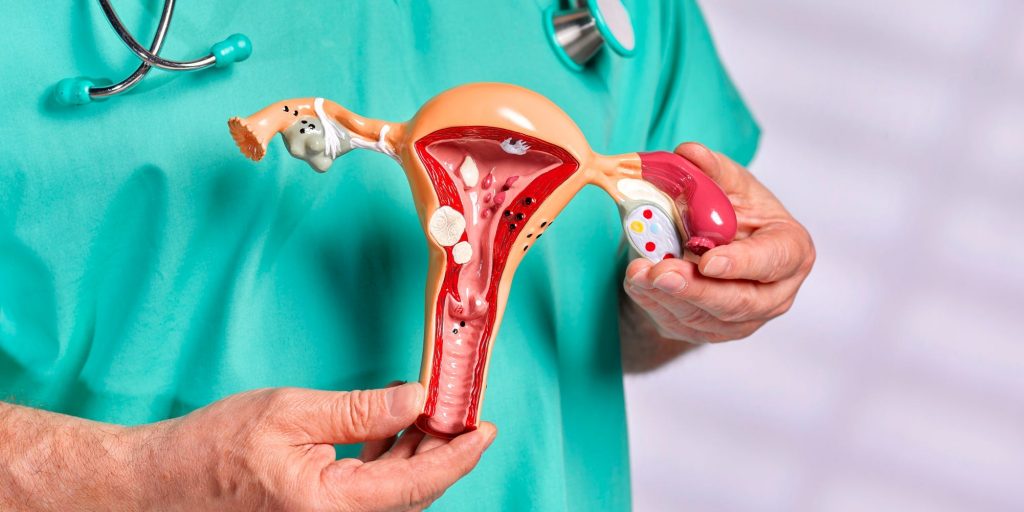- Vaginal prolapse occurs when pelvic organs migrate down towards the opening of the vagina.
- It typically occurs because of muscle weakening due to age, giving birth, heavy lifting, and more.
- Vaginal prolapse can be treated by pelvic floor therapy, supportive devices, or surgery.
Vaginal prolapse, sometimes referred to as pelvic organ prolapse, is a common condition that affects over one-third of US women in their lifetime, especially later in life.
A prolapse is when an organ shifts out of its usual position, so a pelvic organ prolapse is when any of your pelvic organs are affected.
Here's what you need to know about vaginal prolapse, different types of prolapse, causes, and treatment.
What is vaginal prolapse?
"Vaginal prolapse is a condition where pelvic organs — such as the bladder, rectum, cervix, uterus, or vagina — can drop from their original location," says Evelyn Nicole Mitchell, MD, OB-GYN at Keck Medicine of USC.
This happens when the muscles that support your pelvic organs weaken, typically due to age or giving birth.
Vaginal prolapse varies in severity and is categorized by stages or degrees.
- First-degree prolapse: The organs have migrated down only a small amount.
- Second-degree prolapse: The organs have reached the vaginal opening.
- Third-degree prolapse: The organs have bulged out of the vagina by up to one centimeter.
- Fourth-degree prolapse: The organs have protruded over one centimeter.
"At its worst, the entire length of the vagina may fall down past the vaginal opening, which is called complete prolapse," says Nancy Ringel, MD, urogynecologist at Yale Medicine and assistant professor at Yale School of Medicine.
Some people are asymptomatic and may not realize that they have a prolapse until it's discovered during a pelvic exam, says Ringel.
However, if you experience symptoms the main ones of vaginal prolapse are:
- Feeling a bulge in the vaginal area
- Sensation of heaviness in the vagina or pelvis
- Sensation of pressure in the vagina or pelvis
- Lower back pain
- Bladder infections
- Trouble with sex
- Difficulty inserting tampons
Additionally, depending on your individual situation, you may notice bladder leaks (urinary incontinence) or internal pressure when passing a bowel movement, says Mitchell.
Types of vaginal prolapse
The different types of vaginal prolapse are categorized by which pelvic organ is falling down, says Ringel.
These types include:
- Cystocele: When the bladder prolapses into the vagina.
- Enterocele: When the small intestine prolapses into the back wall of the vagina.
- Rectocele: When the rectum prolapses into the vagina.
- Uterine prolapse: When the uterus prolapses into the vagina.
- Urethrocele: When the urethra prolapses into the vagina.
- Vaginal vault prolapse: When the top of the vagina prolapses into the vaginal canal.
What causes vaginal prolapse?
"Anything that leads to increased pressure and strain on the normal support structures in the pelvis can cause prolapse. This can be due to having a baby, having a chronic cough, having constipation, or a variety of other things that can weaken your ligaments and muscles with time," says Ringel.
A variety of potential causes and risk factors include:
- Aging: You're more likely to develop a pelvic floor disorder as you get older and your pelvic floor muscles weaken. This is typically seen in people 60 and older.
- Giving birth: When you have a baby, especially through vaginal delivery, your pelvic floor can be strained. Having a baby over eight and a half pounds increases your risk further. Also, having twins and/or multiple births lead to increased strain and pressure on the pelvic floor, increasing your risk further.
- Menopause: Drops in estrogen associated with menopause may incease your risk.
- Surgery: Surgeries such as hysterectomies may result in prolapse.
- Heavy lifting: Straining with heavy lifting or other types of extreme physical activity can weaken your pelvic floor.
- Chronic pressure on your abdomen: This can be due to obesity, having a chronic cough, or chronically straining during bowel movements due to constipation.
- Family history: If you have a family history of pelvic organ prolapse, you may be genetically predisposed to developing it yourself.
How to treat vaginal prolapse
The treatment for your vaginal prolapse will depend on how severe it is. Mitchell says treatment options include:
- Pelvic floor physical therapy: You can do certain exercises, such as Kegels, to help strengthen the muscles of your pelvic floor. This can be done at home by yourself, but seeing a pelvic floor physical therapist can help with more hands-on instruction.
- Pessaries: A pessary is a ring-like device that you insert into your vagina which can help provide structure to hold your pelvic organs in place. It must be fitted and inserted by your doctor. Typically, this is worn indefinitely under the discretion of your medical provider.
- Surgery: In more severe cases where pelvic floor exercise or the use of a pessary isn't enough, surgery may be needed. Surgical procedures can lift and hold the vagina in place. In rarer cases, usually in older women, surgery may involve stitching the vagina closed permanently.
Insider's takeaway
Vaginal prolapse is when any of your pelvic floor organs drop into (or out of) the vagina. It can be caused by various factors such as childbirth, aging, and chronic pressure on the abdomen.
If you're diagnosed with vaginal prolapse, treatments range from pelvic floor exercises to surgery and can help correct the prolapse.
"If you feel a bulge in the vaginal area, or a sensation of heaviness or pressure, it would be a good idea to see your doctor to see if you have prolapse. In general, if anything doesn't feel right, it never hurts to see your doctor to get an idea about what could be happening," says Ringel.
